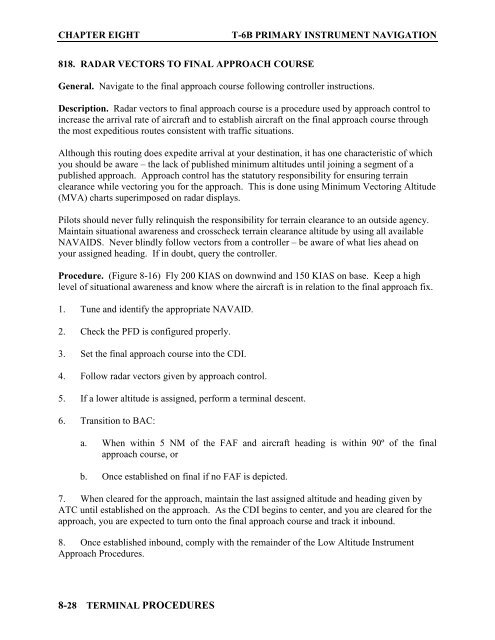Flight Training Instruction - Cnatra - U.S. Navy
Flight Training Instruction - Cnatra - U.S. Navy
Flight Training Instruction - Cnatra - U.S. Navy
Create successful ePaper yourself
Turn your PDF publications into a flip-book with our unique Google optimized e-Paper software.
CHAPTER EIGHT T-6B PRIMARY INSTRUMENT NAVIGATION<br />
818. RADAR VECTORS TO FINAL APPROACH COURSE<br />
General. Navigate to the final approach course following controller instructions.<br />
Description. Radar vectors to final approach course is a procedure used by approach control to<br />
increase the arrival rate of aircraft and to establish aircraft on the final approach course through<br />
the most expeditious routes consistent with traffic situations.<br />
Although this routing does expedite arrival at your destination, it has one characteristic of which<br />
you should be aware – the lack of published minimum altitudes until joining a segment of a<br />
published approach. Approach control has the statutory responsibility for ensuring terrain<br />
clearance while vectoring you for the approach. This is done using Minimum Vectoring Altitude<br />
(MVA) charts superimposed on radar displays.<br />
Pilots should never fully relinquish the responsibility for terrain clearance to an outside agency.<br />
Maintain situational awareness and crosscheck terrain clearance altitude by using all available<br />
NAVAIDS. Never blindly follow vectors from a controller – be aware of what lies ahead on<br />
your assigned heading. If in doubt, query the controller.<br />
Procedure. (Figure 8-16) Fly 200 KIAS on downwind and 150 KIAS on base. Keep a high<br />
level of situational awareness and know where the aircraft is in relation to the final approach fix.<br />
1. Tune and identify the appropriate NAVAID.<br />
2. Check the PFD is configured properly.<br />
3. Set the final approach course into the CDI.<br />
4. Follow radar vectors given by approach control.<br />
5. If a lower altitude is assigned, perform a terminal descent.<br />
6. Transition to BAC:<br />
a. When within 5 NM of the FAF and aircraft heading is within 90º of the final<br />
approach course, or<br />
b. Once established on final if no FAF is depicted.<br />
7. When cleared for the approach, maintain the last assigned altitude and heading given by<br />
ATC until established on the approach. As the CDI begins to center, and you are cleared for the<br />
approach, you are expected to turn onto the final approach course and track it inbound.<br />
8. Once established inbound, comply with the remainder of the Low Altitude Instrument<br />
Approach Procedures.<br />
8-28 TERMINAL PROCEDURES
















